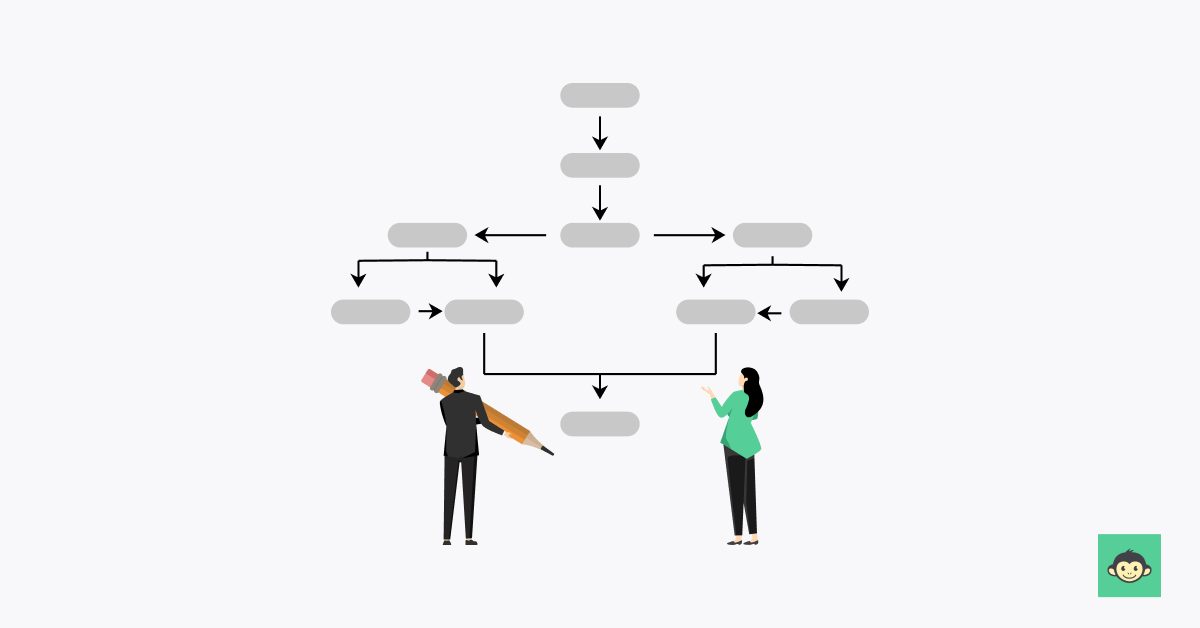What are organizational silos: Definition and top strategies to prevent them in your team in 2024

Organizational silos represent isolated pockets within an organization where departments or teams operate independently, often to the detriment of seamless communication and collaboration. Imagine a symphony where each instrument plays its own tune, oblivious to the harmonious masterpiece waiting to be created.
From corporate giants to agile startups, no entity is immune to the subtle erosion caused by these silos, where departments become self-contained entities with limited interaction, hindering the cross-pollination of ideas.
This blog aims to unravel the complexities surrounding organizational silo mentality, shedding light on their origins, manifestations, and, most importantly, strategies to dismantle these barriers.
Organizational silos definition

Organizational silos refer to the structural and cultural barriers that exist within a company, preventing effective communication, collaboration, and information-sharing between different teams, departments, or functional areas.
These silos can manifest as isolated pockets of activity where teams operate independently, with limited interaction or awareness of the broader organizational objectives.
Silos can arise from various factors, including hierarchical structures, departmentalization, divergent company goals, and a lack of communication channels. The consequence of these barriers is often a fragmented work environment where knowledge and resources are not optimally utilized.
This isolation can impede organizational agility, hinder innovation, and result in inefficiencies as teams work in isolation rather than synergistically. The term "organizational silos" underscores the metaphorical idea of isolated structures, much like grain silos that store and compartmentalize resources.
Breaking down these silos involves fostering a more collaborative and cross-functional approach, encouraging open communication, shared goals, and a collective focus on the overall success of the organization.
Overcoming silos in an entire organization is crucial for promoting a more agile, responsive, and innovative workplace that can adapt to the dynamic challenges of today's business landscape.
What are the 3 major types of silos in business?

In business, organizational silos can manifest in various forms, and three major types are commonly identified:
1. Structural silos
Structural silos are the most apparent and tangible form of organizational separation. These silos arise from the way a company structures its departments or divisions.
When each department operates as an independent entity with limited collaboration with others, a structural, siloed organization is formed. This type of silo can hinder the flow of information and create barriers to effective communication and coordination.
2. Cultural silos
Cultural silos are less tangible but equally impactful. They arise from a company's culture, which may emphasize departmental interests over the overarching goals of the organization.
In a culture dominated by silos, employees may identify more strongly with their department or team than with the organization as a whole. This mindset can lead to a lack of cooperation, resistance to change, and a reluctance to share information across departments.
3. Technological silos
Technological silos emerge when different departments or teams within an organization use disparate tools, software, or systems that are not integrated. This lack of interoperability can result in data inconsistencies, inefficiencies, and difficulties in sharing critical information.
Technological silos hinder the seamless flow of data and impede the organization's ability to harness the full potential of its technological infrastructure.
Addressing these silos involves a comprehensive approach that may include organizational restructuring, fostering a collaborative culture, and implementing integrated technologies to promote smoother communication and cooperation across the entire business ecosystem.
What causes organizational silos?

Organizational silos can arise from a combination of structural, cultural, and operational factors within a company. Here are some common causes of organizational and operational silos:
Departmentalization
The traditional practice of organizing a company into distinct departments or functional areas can inadvertently lead to silos.
When departments (like marketing team or sales team) operate independently with limited interaction with one department, communication barriers arise, hindering the exchange of information and collaboration.
Hierarchical structure
A hierarchical organizational structure can contribute to silos, as decision-making tends to be centralized. Communication often flows vertically, and departments may operate in isolation, with limited awareness of the broader organizational goals and activities.
Lack of communication channels
Inadequate communication channels or the absence of formal mechanisms for sharing information can result in departmental silos. When teams are not encouraged or equipped to communicate across departmental boundaries, information remains confined within siloed units.
Divergent goals and incentives
When departments have conflicting goals or are incentivized based solely on their individual performance metrics, it can create silos. In such cases, teams may prioritize their own goals and objectives over collaborative efforts that benefit the organization as a whole.
Lack of cross-functional teams
If a company primarily operates through isolated, function-specific teams and does not encourage the formation of cross-functional teams, silos can emerge. Cross-team collaboration is essential for addressing complex challenges that require diverse expertise.
Limited information sharing
Silos often form when there is a lack of transparency and information sharing between departments. If information is hoarded or not disseminated effectively, it can create barriers and hinder collective problem-solving.
Technological barriers
The use of incompatible or non-integrated technologies can contribute to silos. When different departments use separate systems that don't communicate seamlessly, it leads to data silos and difficulties in sharing information across the organization.
What are the organizational silos’ impact on employee engagement?

Organizational silos can have a significant impact on employee engagement, influencing various aspects of an employee's experience within the company. Here are several ways in which organizational silos can affect employee engagement:
Limited collaboration and communication
Silos create barriers to collaboration and communication between different departments or teams. Employees working within silos may feel isolated, leading to a lack of engagement as they miss out on valuable interactions with colleagues from other teams or areas of the organization.
Reduced sense of purpose
When employees are confined to their specific silos, they may struggle to see the broader purpose or goals of the organization. This lack of visibility into the overall mission can diminish their sense of purpose and connection to the company's objectives, impacting their engagement levels.
Difficulty in information sharing
Silos hinder the free flow of information across the organization. Employees may find it challenging to access relevant information from other departments, leading to frustration and a sense of being uninformed. This lack of transparency can erode trust and engagement.
Inefficient work processes
Silos often result in duplicated efforts, task duplication, and inefficient work processes. When teams operate independently without knowledge of each other's activities, employees may find themselves repeating tasks or working on projects with overlapping goals. This inefficiency can lead to frustration and disengagement.
Limited career development opportunities
Silos can restrict employees' exposure to different areas of the organization, limiting their chances for career development and growth. Without opportunities to collaborate across departments, employees may feel stagnant in their roles, which can negatively impact their engagement and motivation.
Impact on employee morale
The presence of silos can contribute to a negative organizational culture, affecting employee morale. The perception that the company operates in isolated units may create a sense of competition rather than collaboration, potentially leading to lower morale and decreased engagement.
Difficulty in problem-solving
Silos hinder the collective problem-solving capacity of the organization. When teams operate in isolation, there is a lack of diverse perspectives and expertise, making it more challenging to address complex issues. This can frustrate employees and diminish their sense of contribution.
How do you break down an organizational silo: 6 Top strategies to try in 2024

Breaking down organizational silos requires a strategic and concerted effort to foster collaboration, open communication, and a shared organizational mindset. Here are six top strategies to recognize organizational silos and break it down in 2024:
- Promote a collaborative sales team culture: Cultivate a culture that values collaboration and teamwork. Encourage employees to collaborate across departments, share information, and work towards common goals. Recognize and reward collaborative efforts to reinforce the importance of teamwork in achieving organizational success.
- Establish cross-functional teams: Create cross-functional teams that bring together individuals from different departments to work on specific projects or initiatives. These teams can break down silos by promoting diverse perspectives, improving communication, and fostering a better understanding of each department's contributions.
- Enhance communication channels: Invest in robust communication channels that facilitate the sharing of information across the organization. Utilize modern communication tools, intranets, and platforms that enable real-time collaboration, making it easier for employees to access and share relevant information with their colleagues.
- Leadership alignment and support: Ensure that the leadership team is aligned in breaking down silos and communicates this commitment throughout the organization. Leaders should model collaborative behavior, actively support cross-functional initiatives, and set expectations for open communication and knowledge-sharing.
- Implement integrated technologies: Adopt technologies that promote integration and interoperability between different departments and individual teams. Integrated systems and platforms can streamline processes, eliminate data silos, and provide a unified view of information across the organization.
- Encourage knowledge sharing: Establish practices that encourage the sharing of knowledge and expertise among employees. Implement knowledge-sharing platforms, conduct regular cross-departmental training sessions, and create forums for employees to showcase their work and insights.
Role of team collaboration surveys in preventing organizational silos

Team collaboration surveys play a crucial role in preventing and mitigating organizational silos by providing valuable insights into the dynamics of team interactions and communication within an organization.
These surveys serve as a proactive tool for assessing the health of collaborative efforts and identifying areas for improvement.
By regularly gauging employee perceptions of teamwork, communication effectiveness, and cross-functional collaboration, organizations gain a comprehensive understanding of potential silo formation.
They also enable leaders to pinpoint specific challenges related to silos, such as inadequate information sharing, cultural barriers, or departmental isolation. Armed with this data, organizations can tailor interventions and strategies to address identified issues, fostering a culture of openness and collaboration.
Moreover, team collaboration surveys empower employees by giving them a voice in shaping the organization's collaborative landscape. This inclusivity not only strengthens engagement but also encourages a sense of shared responsibility for breaking down silos.
The real-time feedback obtained from these surveys allows organizations to adapt quickly to changing dynamics, ensuring that collaborative initiatives are effective and aligned with the evolving needs of the workforce.
Ultimately, team collaboration surveys serve as a proactive measure, equipping organizations with the information needed to dismantle silos, enhance communication, and create an environment where cross-functional teamwork thrives.
Conclusion
Breaking down organizational silos is imperative for fostering a culture of collaboration and ensuring organizational success.
By addressing structural, cultural, and technological barriers through strategies such as promoting collaboration, establishing cross-functional teams, and leveraging technology, organizations can dismantle silos and encourage seamless communication.
Team collaboration surveys play a pivotal role in this process, providing valuable insights and empowering employees to contribute to a culture of openness.
As we navigate the evolving landscape of 2024, organizations that prioritize breaking down silos will not only enhance employee engagement but also unlock innovation, efficiency, and the collective potential of their workforce.



